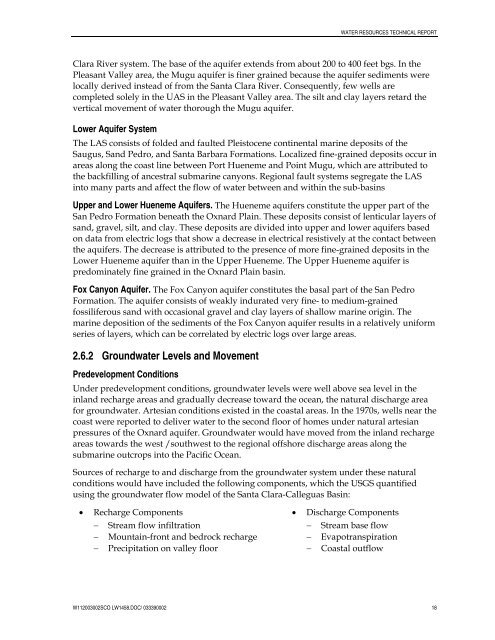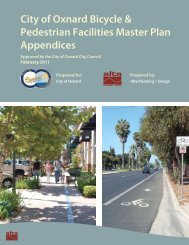View File - Development Services - City of Oxnard
View File - Development Services - City of Oxnard
View File - Development Services - City of Oxnard
You also want an ePaper? Increase the reach of your titles
YUMPU automatically turns print PDFs into web optimized ePapers that Google loves.
WATER RESOURCES TECHNICAL REPORTClara River system. The base <strong>of</strong> the aquifer extends from about 200 to 400 feet bgs. In thePleasant Valley area, the Mugu aquifer is finer grained because the aquifer sediments werelocally derived instead <strong>of</strong> from the Santa Clara River. Consequently, few wells arecompleted solely in the UAS in the Pleasant Valley area. The silt and clay layers retard thevertical movement <strong>of</strong> water thorough the Mugu aquifer.Lower Aquifer SystemThe LAS consists <strong>of</strong> folded and faulted Pleistocene continental marine deposits <strong>of</strong> theSaugus, Sand Pedro, and Santa Barbara Formations. Localized fine-grained deposits occur inareas along the coast line between Port Hueneme and Point Mugu, which are attributed tothe backfilling <strong>of</strong> ancestral submarine canyons. Regional fault systems segregate the LASinto many parts and affect the flow <strong>of</strong> water between and within the sub-basinsUpper and Lower Hueneme Aquifers. The Hueneme aquifers constitute the upper part <strong>of</strong> theSan Pedro Formation beneath the <strong>Oxnard</strong> Plain. These deposits consist <strong>of</strong> lenticular layers <strong>of</strong>sand, gravel, silt, and clay. These deposits are divided into upper and lower aquifers basedon data from electric logs that show a decrease in electrical resistively at the contact betweenthe aquifers. The decrease is attributed to the presence <strong>of</strong> more fine-grained deposits in theLower Hueneme aquifer than in the Upper Hueneme. The Upper Hueneme aquifer ispredominately fine grained in the <strong>Oxnard</strong> Plain basin.Fox Canyon Aquifer. The Fox Canyon aquifer constitutes the basal part <strong>of</strong> the San PedroFormation. The aquifer consists <strong>of</strong> weakly indurated very fine- to medium-grainedfossiliferous sand with occasional gravel and clay layers <strong>of</strong> shallow marine origin. Themarine deposition <strong>of</strong> the sediments <strong>of</strong> the Fox Canyon aquifer results in a relatively uniformseries <strong>of</strong> layers, which can be correlated by electric logs over large areas.2.6.2 Groundwater Levels and MovementPredevelopment ConditionsUnder predevelopment conditions, groundwater levels were well above sea level in theinland recharge areas and gradually decrease toward the ocean, the natural discharge areafor groundwater. Artesian conditions existed in the coastal areas. In the 1970s, wells near thecoast were reported to deliver water to the second floor <strong>of</strong> homes under natural artesianpressures <strong>of</strong> the <strong>Oxnard</strong> aquifer. Groundwater would have moved from the inland rechargeareas towards the west /southwest to the regional <strong>of</strong>fshore discharge areas along thesubmarine outcrops into the Pacific Ocean.Sources <strong>of</strong> recharge to and discharge from the groundwater system under these naturalconditions would have included the following components, which the USGS quantifiedusing the groundwater flow model <strong>of</strong> the Santa Clara-Calleguas Basin:• Recharge Components− Stream flow infiltration− Mountain-front and bedrock recharge− Precipitation on valley floor• Discharge Components− Stream base flow− Evapotranspiration− Coastal outflowW112003002SCO LW1458.DOC/ 033390002 18
















